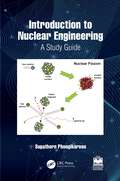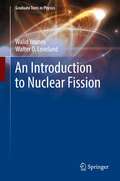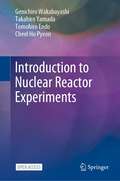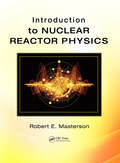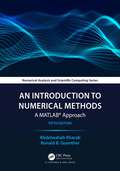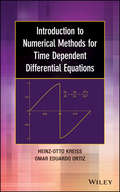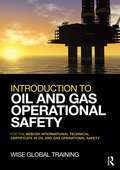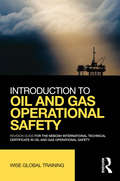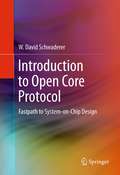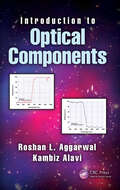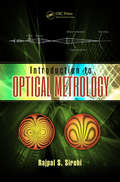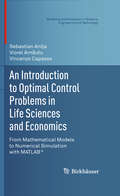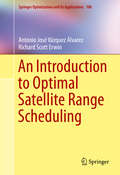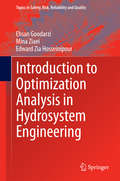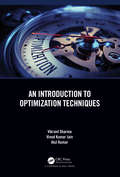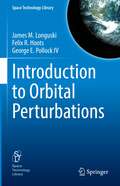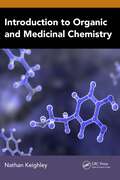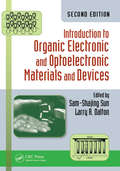- Table View
- List View
Introduction to Nonlinear Circuits and Networks
by Bharathwaj Muthuswamy Santo BanerjeeThis course-based text revisits classic concepts in nonlinear circuit theory from a very much introductory point of view: the presentation is completely self-contained and does not assume any prior knowledge of circuit theory. It is simply assumed that readers have taken a first-year undergraduate course in differential and integral calculus, along with an elementary physics course in classical mechanics and electrodynamics. Further, it discusses topics not typically found in standard textbooks, such as nonlinear operational amplifier circuits, nonlinear chaotic circuits and memristor networks. Each chapter includes a set of illustrative and worked examples, along with end-of-chapter exercises and lab exercises using the QUCS open-source circuit simulator. Solutions and other material are provided on the YouTube channel created for this book by the authors.
Introduction to Nuclear Engineering: A Study Guide
by Supathorn PhongikaroonIntroduction to Nuclear Engineering serves as an accompanying study guide for a complete, introductory single-semester course in nuclear engineering. It is structured for general class use, alongside fundamental nuclear physics and engineering textbooks, and it is equally suited for individual self-study.The book begins with basic modern physics with atomic and nuclear models. It goes on to cover nuclear energetics, radioactivity and decays, and binary nuclear reactions and basic fusion. Exploring basic radiation interactions with matter, the book finishes by discussing nuclear reactor physics, nuclear fuel cycles, and radiation doses and hazard assessment. Each chapter highlights basic concepts, examples, problems with answers, and a final assessment.The book is intended for first-year undergraduate and graduate engineering students taking Nuclear Engineering and Nuclear Energy courses.
An Introduction to Nuclear Fission (Graduate Texts in Physics)
by Walid Younes Walter D. LovelandThis hands-on textbook introduces physics and nuclear engineering students to the experimental and theoretical aspects of fission physics for research and applications through worked examples and problem sets. The study of nuclear fission is currently undergoing a renaissance. Recent advances in the field create the opportunity to develop more reliable models of fission predictability and to supply measurements and data to critical applications including nuclear energy, national security and counter-proliferation, and medical isotope production. An Introduction to Nuclear Fission provides foundational knowledge for the next generation of researchers to contribute to nuclear fission physics.
Introduction to Nuclear Power
by Geoffrey F. Hewitt John G. CollierThe authors of this text aim to educate the reader on nuclear power and its future potential. It focuses on nuclear accidents such as Chernobyl and Three Mile Island, and their consequences, with the understanding that there are safety lessons to be learned if nuclear power generation is going to be expanded to meet our growing energy needs.
Introduction to Nuclear Reactor Experiments
by Genichiro Wakabayashi Takahiro Yamada Tomohiro Endo Cheol Ho PyeonThis open access book is a pedagogical text on nuclear reactor experiments, covering almost all the experiments that can be carried out at the University Training Reactor, Kindai University (UTR-KINKI) with respect to reactor physics and radiation detection, and additionally including academic materials of test and research reactors, nuclear instrumentation, nuclear laws and regulations, in this main body. The book is an excellent primer for students who are interested in reactor physics, radiation detection, nuclear laws and regulations at universities, and the best textbook for students who have started to study the nuclear energy related fields to understand the basic theories and principles of the experiments in the fields of reactor physics and radiation detection. UTR-KINKI has been used for educational reactor experiments and basic research in a wide range of fields related to the use of radiation (neutrons, gamma-ray, beta-ray, alpha-ray, and X-ray), including reactor physics, radiation detection, radiation health physics, activation analysis, radiation biology, medical applications and archaeology. Also, UTR-KINKI has been actively engaged in nuclear education with its long history of operation, and has gained extensive experience in educational activities for undergraduate and graduate students, elementary, junior high and high school teachers, junior high and high school students, and general audiences.
Introduction to Nuclear Reactor Physics
by Robert E. MastersonINTRODUCTION TO NUCLEAR REACTOR PHYSICS is the most comprehensive, modern and readable textbook for this course/module. It explains reactors, fuel cycles, radioisotopes, radioactive materials, design, and operation. Chain reaction and fission reactor concepts are presented, plus advanced coverage including neutron diffusion theory. The diffusion equation, Fisk’s Law, and steady state/time-dependent reactor behavior. Numerical and analytical solutions are also covered. The text has full color illustrations throughout, and a wide range of student learning features.
Introduction to Numerical and Analytical Methods with MATLAB for Engineers and Scientists
by William BoberThis textbook teaches students how to write computer programs on the MATLAB platform and to use many of MATLAB's built-in functions to solve engineering-type problems. To students, MATLAB's built-in functions are black boxes. By combining a textbook on MATLAB with basic numerical and analytical analysis, the mystery of what the black boxes contain is somewhat alleviated. Within each chapter there are exercises related to the topics just covered. The text contains many examples from mechanical, civil, aeronautical, and electrical engineering.
An Introduction to Numerical Methods: A MATLAB Approach (Fourth Edition)
by Abdelwahab Kharab Ronald GuentherPrevious editions of this popular textbook offered an accessible and practical introduction to numerical analysis. An Introduction to Numerical Methods: A MATLAB Approach, Fourth Edition continues to present a wide range of useful and important algorithms for scientific and engineering applications. The authors use MATLAB to illustrate each numerical method, providing full details of the computed results so that the main steps are easily visualized and interpreted. This edition also includes a new chapter on Dynamical Systems and Chaos.
An Introduction to Numerical Methods: A MATLAB® Approach (Chapman & Hall/CRC Numerical Analysis and Scientific Computing Series)
by Abdelwahab Kharab Ronald GuentherAn Introduction to Numerical Methods: A MATLAB® Approach, Fifth Edition continues to offer readers an accessible and practical introduction to numerical analysis. It presents a wide range of useful and important algorithms for scientific and engineering applications, using MATLAB to illustrate each numerical method with full details of the computed results so that the main steps are easily visualized and interpreted. This edition also includes new chapters on Approximation of Continuous Functions and Dealing with Large Sets of Data. Features: Covers the most common numerical methods encountered in science and engineering Illustrates the methods using MATLAB Ideal as an undergraduate textbook for numerical analysis Presents numerous examples and exercises, with selected answers provided at the back of the book Accompanied by downloadable MATLAB code hosted at https/www.routledge.com/ 9781032406824
Introduction to Numerical Methods for Time Dependent Differential Equations
by Heinz-Otto Kreiss Omar Eduardo OrtizIntroduces both the fundamentals of time dependent differential equations and their numerical solutionsIntroduction to Numerical Methods for Time Dependent Differential Equations delves into the underlying mathematical theory needed to solve time dependent differential equations numerically. Written as a self-contained introduction, the book is divided into two parts to emphasize both ordinary differential equations (ODEs) and partial differential equations (PDEs).Beginning with ODEs and their approximations, the authors provide a crucial presentation of fundamental notions, such as the theory of scalar equations, finite difference approximations, and the Explicit Euler method. Next, a discussion on higher order approximations, implicit methods, multistep methods, Fourier interpolation, PDEs in one space dimension as well as their related systems is provided.Introduction to Numerical Methods for Time Dependent Differential Equations features:A step-by-step discussion of the procedures needed to prove the stability of difference approximationsMultiple exercises throughout with select answers, providing readers with a practical guide to understanding the approximations of differential equationsA simplified approach in a one space dimensionAnalytical theory for difference approximations that is particularly useful to clarify proceduresIntroduction to Numerical Methods for Time Dependent Differential Equations is an excellent textbook for upper-undergraduate courses in applied mathematics, engineering, and physics as well as a useful reference for physical scientists, engineers, numerical analysts, and mathematical modelers who use numerical experiments to test designs or predict and investigate phenomena from many disciplines.
An Introduction to Ocean Remote Sensing
by Seelye MartinExamining the use of satellite data in the retrieval of oceanic physical and biological properties, this study presents examples of the kinds of data that can be acquired and recounts their oceanographic application. It also describes the national and international programs in satellite oceanography of the past two decades, and reviews current and future programs up to 2019. The textbook, designed for graduate and senior undergraduate courses in satellite oceanography, will prepare students and interested scientists to use satellite data in oceanographic research.
Introduction to Oil and Gas Operational Safety: for the NEBOSH International Technical Certificate in Oil and Gas Operational Safety
by Wise Global Training LtdIntroduction to Oil and Gas Operational Safety is aligned directly to the NEBOSH International Technical Certificate in Oil and Gas Operational Safety. Concisely written by a highly experienced team, this full colour reference provides complete coverage of the syllabus, including chapters on fire hazards, risk management and emergency response. It will ensure that you are fully equipped with the knowledge and understanding to respond and deal with the daily hazards you may face whilst working in the oil and gas industry. Complete with tables, case studies and self-test questions, this book will guide you through the principles of how to manage both offshore and onshore operational risks to prepare you for your exam and beyond.
Introduction to Oil and Gas Operational Safety: Revision Guide for the NEBOSH International Technical Certificate in Oil and Gas Operational Safety
by Wise Global Training LtdThis companion to Introduction to Oil and Gas Operational Safety will help you to prepare for the written assessment of the NEBOSH International Technical Certificate in Oil and Gas Operational Safety. Aligned directly to the NEBOSH syllabus, this revision guide includes learning outcomes and key revision points to help you consolidate your knowledge to enable you to effectively discharge workplace safety and responsibilities. With reference to the textbook, this revision guide provides complete syllabus coverage in bite sized chunks to help you pass the certificate and become an efficient practitioner in the Oil and Gas industry. Small, handy size making it ideal for use at home, in the classroom or on the move Includes revision exercises and answers to check your understanding Everything you need for productive revision in one handy reference source
Introduction to Open Core Protocol
by W David SchwadererThis book introduces Open Core Protocol (OCP) not as a conventional hardware communications protocol but as a meta-protocol: a means for describing and capturing the communications requirements of an IP core, and mapping them to a specific set of signals with known semantics. Readers will learn the capabilities of OCP as a semiconductor hardware interface specification that allows different System-On-Chip (SoC) cores to communicate. The OCP methodology presented enables intellectual property designers to design core interfaces in standard ways. This facilitates reusing OCP-compliant cores across multiple SoC designs which, in turn, drastically reduces design times, support costs, and overall cost for electronics/SoCs.
Introduction to Optical and Optoelectronic Properties of Nanostructures
by Vladimir V. Mitin Viacheslav A. Kochelap Mitra Dutta Michael A. StroscioGet to grips with the fundamental optical and optoelectronic properties of nanostructures. This comprehensive guide makes a wide variety of modern topics accessible, and includes up-to-date material on the optical properties of monolayer crystals, plasmonics, nanophotonics, UV quantum well lasers, and wide bandgap materials and heterostructures. The unified, multidisciplinary approach makes it ideal for those in disciplines spanning nanoscience, physics, materials science, and optical, electrical and mechanical engineering. Building on work first presented in Quantum Heterostructures (Cambridge, 1999), this volume draws on years of research and teaching experience. Rigorous coverage of basic principles makes it an excellent resource for senior undergraduates, and detailed mathematical derivations illuminate concepts for graduate students, researchers and professional engineers. The examples with solutions included in the text and end-of-chapter problems allows the students to use this text to enhance their understanding.
Introduction to Optical Components
by Roshan L. Aggarwal Kambiz AlaviThis book provides readers with a brief introduction to optical components. Materials presented in this book prepare readers to deal with optical components in the areas of optics and optical technology. Introduction to Optical Components features nine chapters with topics ranging from lenses (materials, magnifiers, and cameras); mirrors (spherical, ellipsoidal, and aberrations); diffraction gratings (holographic and multilayer dielectric); polarizers (birefringent, reflective, and Jones matrix algebra); windows (UV and AR coating materials); filters (neutral density and Raman); beamsplitters (plate, cube, and pellicle); sources (light-emitting diodes and lasers); and detectors (thermal, photon, and photodetector noise). <P><P>This text also features a detailed discussion of non-ideal effects for practical components using minimal amounts of derivations (that do not compromise essential physical, mathematical, or material properties). While there are numerous books that feature "optical" in their title, to date, no textbook on optical components exists. It is for this reason that Introduction to Optical Components is such a vital resource. The technical level of this book is equivalent to an undergraduate course in the optics and optical technology curriculum. Students are required to have little familiarity with optics. Practitioners in optics and optical technology will also find this book useful. Each chapter includes numerous mathematical equations; tables providing useful optical parameters for many optical materials; and end-of-chapter questions and their corresponding solutions.
Introduction to Optical Metrology (Optical Sciences and Applications of Light)
by Rajpal S. SirohiIntroduction to Optical Metrology examines the theory and practice of various measurement methodologies utilizing the wave nature of light. The book begins by introducing the subject of optics, and then addresses the propagation of laser beams through free space and optical systems. After explaining how a Gaussian beam propagates, how to set up a collimator to get a collimated beam for experimentation, and how to detect and record optical signals, the text: Discusses interferometry, speckle metrology, moiré phenomenon, photoelasticity, and microscopy Describes the different principles used to measure the refractive indices of solids, liquids, and gases Presents methods for measuring curvature, focal length, angle, thickness, velocity, pressure, and length Details techniques for optical testing as well as for making fiber optic- and MEMS-based measurements Depicts a wave propagating in the positive z-direction by ei(ωt – kz), as opposed to ei(kz – ωt) Featuring exercise problems at the end of each chapter, Introduction to Optical Metrology provides an applied understanding of essential optical measurement concepts, techniques, and procedures.
Introduction to Optical Microscopy
by Jerome MertzThis fully updated, self-contained textbook covering modern optical microscopy equips students with a solid understanding of the theory underlying a range of advanced techniques. Two new chapters cover pump-probe techniques, and imaging in scattering media, and additional material throughout covers light-sheet microscopy, image scanning microscopy, and much more. An array of practical techniques are discussed, from classical phase contrast and confocal microscopy, to holographic, structured illumination, multi-photon, and coherent Raman microscopy, and optical coherence tomography. Fundamental topics are also covered, including Fourier optics, partial coherence, 3D imaging theory, statistical optics, and the physics of scattering and fluorescence. With a wealth of end-of-chapter problems, and a solutions manual for instructors available online, this is an invaluable book for electrical engineering, biomedical engineering, and physics students taking graduate courses on optical microscopy, as well as advanced undergraduates, professionals, and researchers looking for an accessible introduction to the field.
An Introduction to Optimal Control Problems in Life Sciences and Economics: From Mathematical Models to Numerical Simulation with MATLAB® (Modeling and Simulation in Science, Engineering and Technology)
by Viorel Arnăutu Sebastian Aniţa Vincenzo CapassoCombining control theory and modeling, this textbook introduces and builds on methods for simulating and tackling concrete problems in a variety of applied sciences. Emphasizing "learning by doing," the authors focus on examples and applications to real-world problems. An elementary presentation of advanced concepts, proofs to introduce new ideas, and carefully presented MATLAB® programs help foster an understanding of the basics, but also lead the way to new, independent research. With minimal prerequisites and exercises in each chapter, this work serves as an excellent textbook and reference for graduate and advanced undergraduate students, researchers, and practitioners in mathematics, physics, engineering, computer science, as well as biology, biotechnology, economics, and finance.
An Introduction to Optimal Satellite Range Scheduling (Springer Optimization and Its Applications #106)
by Antonio José Vázquez Álvarez Richard Scott ErwinThe satellite range scheduling (SRS) problem, an important operations research problem in the aerospace industry consisting of allocating tasks among satellites and Earth-bound objects, is examined in this book. SRS principles and solutions are applicable to many areas, including: Satellite communications, where tasks are communication intervals between sets of satellites and ground stations Earth observation, where tasks are observations of spots on the Earth by satellites Sensor scheduling, where tasks are observations of satellites by sensors on the Earth. This self-contained monograph begins with a structured compendium of the problem and moves on to explain the optimal approach to the solution, which includes aspects from graph theory, set theory, game theory and belief networks. This book is accessible to students, professionals and researchers in a variety of fields, including: operations research, optimization, scheduling theory, dynamic programming and game theory. Taking account of the distributed, stochastic and dynamic variants of the problem, this book presents the optimal solution to the fixed interval SRS problem and how to migrate results into more complex cases. Reference algorithms and traditional algorithms for solving the scheduling problems are provided and compared with examples and simulations in practical scenarios.
Introduction to Optimization Analysis in Hydrosystem Engineering
by Ehsan Goodarzi Mina Ziaei Edward Zia HosseinipourThis book presents the basics of linear and nonlinear optimization analysis for both single and multi-objective problems in hydrosystem engineering. The book includes several examples with various levels of complexity in different fields of water resources engineering. The examples are solved step by step to assist the reader and to make it easier to understand the concepts. In addition, the latest tools and methods are presented to help students, researchers, engineers and water managers to properly conceptualize and formulate resource allocation problems, and to deal with the complexity of constraints in water demand and available supplies in an appropriate way.
An Introduction to Optimization Techniques
by Vikrant Sharma Vinod Kumar Jain Atul KumarAn Introduction to Optimization Techniques introduces the basic ideas and techniques of optimization. Optimization is a precise procedure using design constraints and criteria to enable the planner to find the optimal solution. Optimization techniques have been applied in numerous fields to deal with different practical problems. This book is designed to give the reader a sense of the challenge of analyzing a given situation and formulating a model for it while explaining the assumptions and inner structure of the methods discussed as fully as possible. It includes real-world examples and applications making the book accessible to a broader readership. Features Each chapter begins with the Learning Outcomes (LO) section, which highlights the critical points of that chapter. All learning outcomes, solved examples and questions are mapped to six Bloom Taxonomy levels (BT Level). Book offers fundamental concepts of optimization without becoming too complicated. A wide range of solved examples are presented in each section after the theoretical discussion to clarify the concept of that section. A separate chapter on the application of spreadsheets to solve different optimization techniques. At the end of each chapter, a summary reinforces key ideas and helps readers recall the concepts discussed. The wide and emerging uses of optimization techniques make it essential for students and professionals. Optimization techniques have been applied in numerous fields to deal with different practical problems. This book serves as a textbook for UG and PG students of science, engineering, and management programs. It will be equally useful for Professionals, Consultants, and Managers.
Introduction to Orbital Perturbations (Space Technology Library #40)
by James M. Longuski Felix R. Hoots George E. Pollock IVThis textbook provides details of the derivation of Lagrange's planetary equations and of the closely related Gauss's variational equations, thereby covering a sorely needed topic in existing literature. Analytical solutions can help verify the results of numerical work, giving one confidence that his or her analysis is correct. The authors—all experienced experts in astrodynamics and space missions—take on the massive derivation problem step by step in order to help readers identify and understand possible analytical solutions in their own endeavors. The stages are elementary yet rigorous; suggested student research project topics are provided.After deriving the variational equations, the authors apply them to many interesting problems, including the Earth-Moon system, the effect of an oblate planet, the perturbation of Mercury's orbit due to General Relativity, and the perturbation due to atmospheric drag. Along the way, they introduce several useful techniques such as averaging, Poincaré's method of small parameters, and variation of parameters. In the end, this textbook will help students, practicing engineers, and professionals across the fields of astrodynamics, astronomy, dynamics, physics, planetary science, spacecraft missions, and others. “An extensive, detailed, yet still easy-to-follow presentation of the field of orbital perturbations.” - Prof. Hanspeter Schaub, Smead Aerospace Engineering Sciences Department, University of Colorado, Boulder “This book, based on decades of teaching experience, is an invaluable resource for aerospace engineering students and practitioners alike who need an in-depth understanding of the equations they use.” - Dr. Jean Albert Kéchichian, The Aerospace Corporation, Retired “Today we look at perturbations through the lens of the modern computer. But knowing the why and the how is equally important. In this well organized and thorough compendium of equations and derivations, the authors bring some of the relevant gems from the past back into the contemporary literature.” - Dr. David A Vallado, Senior Research Astrodynamicist, COMSPOC “The book presentation is with the thoroughness that one always sees with these authors. Their theoretical development is followed with a set of Earth orbiting and Solar System examples demonstrating the application of Lagrange’s planetary equations for systems with both conservative and nonconservative forces, some of which are not seen in orbital mechanics books.” - Prof. Kyle T. Alfriend, University Distinguished Professor, Texas A&M University
Introduction to Organic and Medicinal Chemistry
by Nathan Jack KeighleyThis text is designed to be an undergraduate reference textbook for students of chemistry who aim to select degree modules geared towards medicinal chemistry. The first two chapters offer an overview of basic organic chemistry, followed by organic synthesis in Chapter 3, with an emphasis on the importance of synthetic procedures in relation to the chemistry of drug design. In Chapter 4, the book covers foundational aspects of biochemistry and biomedical science to provide a basis for students understanding where and how drugs work on selected targets. Later, the book explains how medicines have been created for selected topics in medicinal chemistry – namely against pathogens, cancer and neurological targets.Features: User-friendly text that deals with key methods in organic synthesis and medicinal chemistry An overture of drug design against disease targets An introduction to the molecular basis of disease and key topics in medicinal chemistry Geared toward chemistry undergraduates with an interest in pursuing medicinal chemistry further into their degree A complete set of tutorial questions and answers for each chapter
Introduction to Organic Electronic and Optoelectronic Materials and Devices
by Sam-Shajing Sun; Larry R. DaltonThis book covers the combined subjects of organic electronic and optoelectronic materials/devices. It is designed for classroom instruction at the senior college level. Highlighting emerging organic and polymeric optoelectronic materials and devices, it presents the fundamentals, principle mechanisms, representative examples, and key data.

